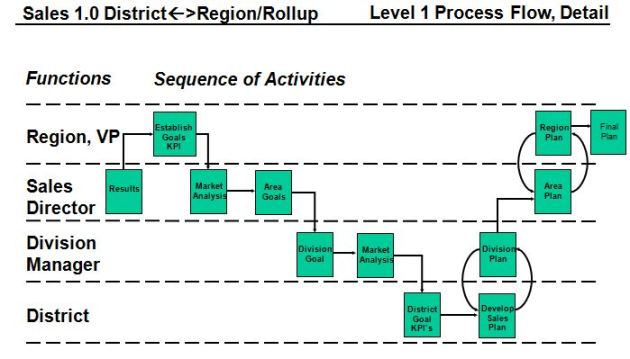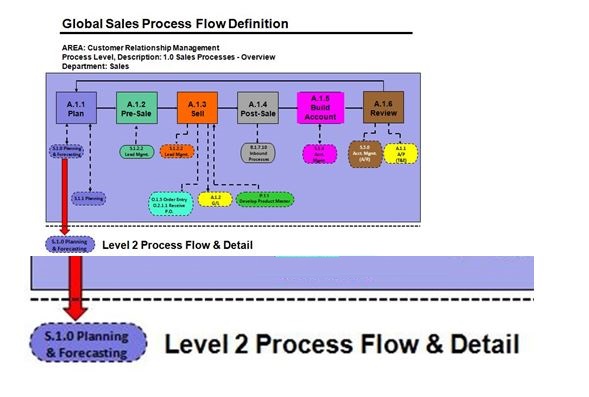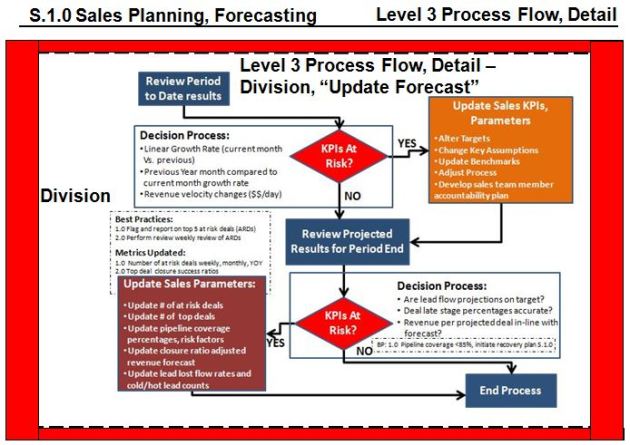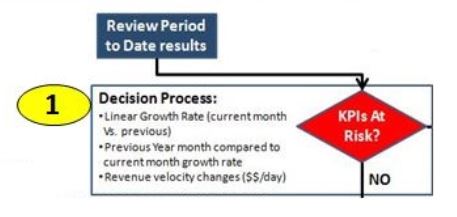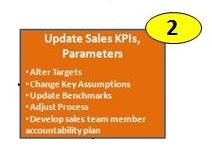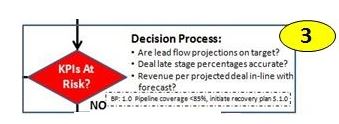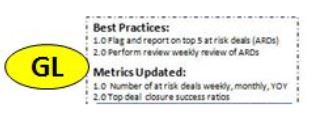World-Class Sales Processes & Methodologies – Insights into How to Achieve Sales Process Excellence
September 5, 2019 Leave a comment
What you will quickly learn in this blog article:
-
The value and ROI of having a world-class sales process.
-
The top 10 benefits to having a clearly articulated sales process and associated methodology.
-
The specific components & elements within each detailed sales process that enables the sales team to maximize their effectiveness.
-
Sample sales metrics that should be collected as part of an overall sales process.
-
How a sales process helps align corporate communications and actions toward winning each and every sale.
-
How to infuse sales best practices right into your sales process at every stage of the sales cycle.
-
How to ensure all levels of the sales teams actions are coordinated in terms of communications, hand-offs, approvals, sales readiness, etc.
-
How a leading practices sales process will actually ensure that you deliver an optimum customer experience where customers will buy more and become loyal.
-
How a best practice based sales methodology will ensure your sales team is fully accountable for results and for the sales funnel.
-
Why a sales process can make it easier to on-board, train and retain a high performing sales team.
-
What critical sales process steps you can be automated once the sales process is fully developed and why sales automation alone (out of the box) won’t deliver sales process excellence.
-
How you can leverage artificial intelligence and robotic process automation (RPA) to offload mundane, lower value tasks from the sales team.
-
Proven and effective sales best practices I have diffused at various Fortune 500 company clients.
B) The Top 10 Reasons Developing & Maintaining a World-Class Sales Process is valuable for you and your company:
- Holds Sales Team Staff and Management Accountable
By having performance measures and toll gates baked right into the overall sales process, you can hold team members accountable for reaching select performance levels at each phase of the sales process
-
Provides a clear & proven path for sales reps to close deals.
By having clearly defined best practice based steps and milestones that guide sales team members, from prospecting to proposal presentation, your company can avoid losing sales deals due to disorganization.
-
Increases sales organization collaboration & synergy
World-class sales processes contain within them the definition of your entire sales communication process including the roles of each department supporting the sales process. This feature of the sales process definition ensures everyone is on the same page and collaborating and communicating at each critical juncture of the sales process to ensure the sale is won.
-
Enables more efficient and effective on-boarding of new sales members
A standardized sales process makes training sales reps fast, simple, and nearly foolproof, by showing salespeople what they need to do in various sales situations without having to tie up the sales manager in the (re) training process. In addition, when the entire sales team is following the same road-map, any member of the existing sales team can pass on their knowledge and guidance to new hires.
-
Provides the ability to constantly improve sales processes and methods.
Successful sales teams continuously refine their sales processes based on the collection of measurable data and constant feedback that will be built right into any world-class sales process. For example, understanding where most of your sales deals are getting bogged down or lost can help you identify the root cause of why those deals were stalled or lost and take steps to re-engineer the sales process. Without a process in place, deals are simply won or lost, and it’s hard to know which specific actions are succeeding or failing.
-
Delivers better forecasting with higher predictability of sales and revenue.
A repeatable sales process provides sales teams with greater consistency in winning deals. Having a more accurate sense of your overall sales win rate enables your company to dependably forecast how many sales you’ll close from a given number of leads, and helps sales managers set realistic team member sales quotas.
-
Drives more qualified leads, increased lifetime value, revenue and profitability
A well honed sales process also enables your sales team to be more effective at filtering out low-potential leads and identifying prospects that are most likely to purchase your product. Generating greater volumes of higher-quality leads shortens your sales cycle and reduces the effort wasted on lower probability sales deals. This also ensures that your sales team focuses its efforts on the activities that deliver the most revenue and the highest levels of profitability.
-
Enables improved communication between sales and supporting teams.
By having your sales team speaking a common company language (vs. sales specific) it can enable better collaboration among sales team members and with supporting company departments. A standardized best practice sales process contains common steps and common language that delivers simplified inter-company communication, reduces inter-departmental confusion, and enables your accounting, customer service, fulfillment, and marketing teams to provide the right sales actions and content at the right time. The following chart is an example of developing a framework for how various sales team members communicate, share and update information, etc.
9. Provides greater measurement of sales team performance
When a sales team has no standardized sales process to follow, it is difficult to measure anything except for wins and losses. A standardized sales process has built into it more data measurement points at each phase of the sales process, allowing for deeper analysis of key sales performance metrics and targets.
10. Delivers a better overall customer experience.
When a sales representative pressures a prospect into a sales stage they are not comfortable with, it can create mistrust, which can negate the sale and damage the relationship with the buyer. A standardized sales process ensures that sales team members and managers do not advance the sale until the prospect is ready to move forward. A best practice sales process also is designed to reflect how each prospect (customized via prospect analytics and profiling) would want to move through the buying process, and making sure each step is designed (customized) to generate maximum trust and value. In this manner the sales process enables sales teams to deliver an optimum and positive customer experience during each sales phase.
C) Global Sales Major Process Definition

World-Class Sales Process Framework
The above is a sanitized version of the highest level sales process architecture I developed for a global consumer products company. This “level 1” foundation sales process architecture depicts the major processes and supporting processes for the overall company sales process. Each of these major process modules will each be further broken down in detail until the actual process steps, procedures and policies are of sufficient detail that they can be clearly followed by all sales stakeholders (sales manages, sales team members, departments supporting the sales team, senior management, etc.).
D) Sales Process Detailed Definition – Responsibilities and Major Processes
Breaking down the major 1.0 level sales process, we flow into the next level of detail for the S.1.0 process which is “Planning and Forecasting” for sales.
Within the “Planning and Forecasting” module we depicted the major coordination and communications that occur with this Level 2 process. The horizontal subdivisions (a.k.a. swim lanes) shows a high level breakdown of responsibilities within the sales organization and between the various functions, regions, etc. This was important for this client since it mapped out who did what and at what level to end up with either a new or revised sales forecast.
E) Sales Process Detailed Definition – Steps, Decision Support, KPIs, Best Practices, Key Metrics
Using the “Updated Forecast” process as an example, we then show the level 3 detail of this sales process.
As shown above, typically a level 3 or 4 process flow contains the sales process detail for it to be actionable by the sales team and supporting team (accounting, IT, fulfillment, product management, customer service, etc.).
F) Detailed Sales Process – Definition of each step & components:
Let’s examine each of the 4 major elements of this level 3.0 process flow titled “Update Forecast”.
The first element we examine is the flow from another detailed process step, “Review Period to Date Results”, that has a number of inputs that into this process step “Update Forecast” at the Division level that include (sample) the following sales period to date information:
-
Projected sales volume vs. actual results
-
Sales representatives goals vs. actual results
-
# of closed sales deals and at risk-deals vs. planned
-
Profitability per deal vs. target
-
Total revenue and profit for all cumulative sales deals vs. target
The 1st process element we examine is the examination and decision based on actual vs. planned period to date sales KPIs as follows:
-
Are we maintaining an upward linear growth rate as planned
-
Previous year same month sales vs. current month
-
Overall sales generated sales velocity ($$ per day, week, month) deltas
If key sales planned period to date KPIs are at risk based on a certain threshold, we move to the 2nd element where we update a number of pre-determined KPIs that are critical to ensuring we have an accurate sales forecast. In this sample, my client decided that these are as follows (sample):
-
Sales targets
-
Key sales assumptions (totals and per deal)
-
Sales benchmarks (top performance vs. average vs. lagging)
-
Sales process (i.e. adjust at-risk deal processes to match on the ground situations for each deal)
-
Sales team accountability plans (adjust according to 1-4 above).
If they are not at major risk, we might update a few smaller parameters and then move onto process step 2A.
The 3rd process element we examine is the examination and decision based on sales project results for period end KPIs as follows (sample):
-
Are lead flow projected rates at previously forecast levels?
-
Are the numbers of late stage sales deals on track to close in the period end (monthly for my client)?
-
Based on the deals closing in #2 above, does the aggregate revenue for those deals match the projected forecast for period end?
-
Specific to this process step, we have an embedded best practice “BP”. This best practice details that if pipeline coverage of sales representatives drops below 85%, an automated process (with its own set of best practice procedures), kicks off titled “Recovery Plan S.1.0” that will return coverage of pipeline to 100%.
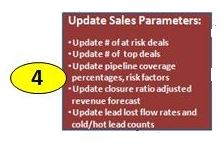
Sales Process Step 4 Detailed, Update Sales Forecast
If key sales project results for period end KPIs are at risk based on a certain threshold, we move to the 4th element where we simply update the key sales projections and KPIs based on investigating and validating actual sales actions, feedback, roadblocks, prospect and customer actions, etc. These include (small sample of actual client metrics) the following:
-
At-risk deals (#’s, specific names, assigned representatives, etc.)
-
Top deal watch list (revenue and margin #’s, names/clients, roadblocks, action plan status, etc.)
-
Low sales performer watch list (names, action plans, mentor-ships, etc.)
If there are no major risks, we might update a few smaller parameters and then move onto process step 4A where we simply exit this process and enter another downstream process.
A global element in this update forecast process is the embedded best practices that have been developed as a result of evolving the sales process continuously. These include (small sample):
-
Flagging the top 5 (based on revenue, important to company) at-risk sales deals.
-
Performing a weekly review of at-risk sales deals and coming up with an action plan for each, taking into account any sales process changes made above in element 3, step 4).
-
Updating the following metrics, key for sales management visibility:
-
Number of at-risk deals weekly, monthly, YOY, etc.
-
The success ratio of closed top deals vs. top deals lost.
-
Average sales cycle duration & actual sales representative time spent selling.
Other Key sales metrics for the overall sales process to consider:
-
Overall sales win rate.
-
Average deal size.
-
Lead average follow-up time. (The time a lead is received until a sale representative follows-up)
-
Sales by lead source (important marketing to sales metric).
-
Quota achievement % total and by sales representative.
-
Based on a-c (and more) above, what are the action plans and automated workflows that need to be created to enact updated performance plan metrics?
G) Sales Process Automation:
There is a huge difference between sales automation and sales process automation. Just because you purchased leading tools like Salesforce, Microsoft, Oracle, Zoho, etc. does not mean it will conform or deliver a highly automated sales process right out of the box. These tools can be customized to accommodate the automation of your sales process, but will take additional $$, effort and potentially additional licenses that you may not have accounted for in the initial expenditure of funds and resources. This step is as important as purchasing the package since without easy to use functionality and processes that aid the sales effort, the tool will be considered more of a hindrance that a help.
You will also need to automate your sales process via a number of other supporting tools that salesforce automation software packages are not optimized for out of the box such as the following:
-
E-mail process automation like triggered responses to new lead inquiries or automated bots on the website to interact and respond to simple initial inquiries.
-
Report generation being triggered based on system parameters, timing and critical thresholds being reached. Add on packages like Adobe, Tableau, Microstrategy, Oracle BI, SAS, Sisense, etc. all are great packages that can be added to bring additional horsepower to your sales analytics and reporting capabilities.
-
Artificial intelligence and robotic process automation (RPA) can aid in the performance of sales tasks such as lead distribution, auto-populating CRM systems via intelligent voice capture and data mining following a phone sales call.
-
Pipeline & Order Management – tools like Vendasta can help automate the management of your pipeline and order management.
H) Other Sales Best Practices to Kick Your Sales Volume & Success into Overdrive:
While these are not related to the above sales process per say, I have included these as they are sales related and **some** clients choose to implement these practices, processes:
-
Analyze sales rainmaker activities & behavior and then replicate their best practices back into the overall sales process, training, activities, sales approaches. In this manner good sales reps move up to rainmaker performance, average sales reps move up to good performance, etc. I did this for a major U.S. insurance company a few years ago and it improved their overall sales performance by 32%!
-
Develop a referral incentive system with your existing customers as existing customer referrals are likely to close 50+% of the time, with strong personal referrals with testimonials likely to close at 80+%. Compare this to warm leads at <30% and cool leads at <15%. I did this as the SVP of Operations at a startup and it catapulted our sales from <$1m to over $3m in just 8 months.
-
Develop a network of complimentary re-sellers (a.k.a. channel sellers) of your services where the products and/or services you sell are complimentary to the re-sellers normal line business. For example, a firm that sells cultural improvement and/or leadership development services should be seeking out an HR consulting firm to resell their services since the HR firm is uncovering these needs on a regular basis with generally nowhere to turn for servicing unearthed client needs. The HR consulting firm would then net a commission (5-10%) for merely opening the door to the new sales opportunity for the leadership development firm. Analogous to this on the web is affiliate sales and marketing.
-
Invite satisfied customers to participate in the brand: guest blogger, posting testimonials, reviewing new concepts, products and/or services, participating on a Customer Advisory Board (e.g. top customers), etc. Studies have shown that the more they are invited to participate in the brand’s success, the more likely they are to share your brand’s success.
-
Let your existing customers know about your sales wins: The more your customers see you succeed and the strides your are making in the marketplace, the more likely they are to share these positive news stories. Examples: xyz company is winning contracts left and right, they must be doing something right, xyz is on fire, xyz services are selling like hotcakes, etc.
Related to the above topic, does your organization need consulting assistance developing and implementing a world-class sales process or any of the following: associated services?
-
Replicating the processes and behavior of your sales rainmakers to the rest of the sales team?
-
Infusing a set of sales cross-industry leading practices in your existing sales process?
-
Developing a best practice sales measurement and metric system?
-
Automating the sales process to offload the non-value sales tasks from your sales team so they can focus on meeting with prospects/customers and closing deals?
-
Investigate how to apply Artificial Intelligence (AI) and Robotic Process Automation (RPA) to sharpen your sales insights, targeting, lead generation flow, etc.?
